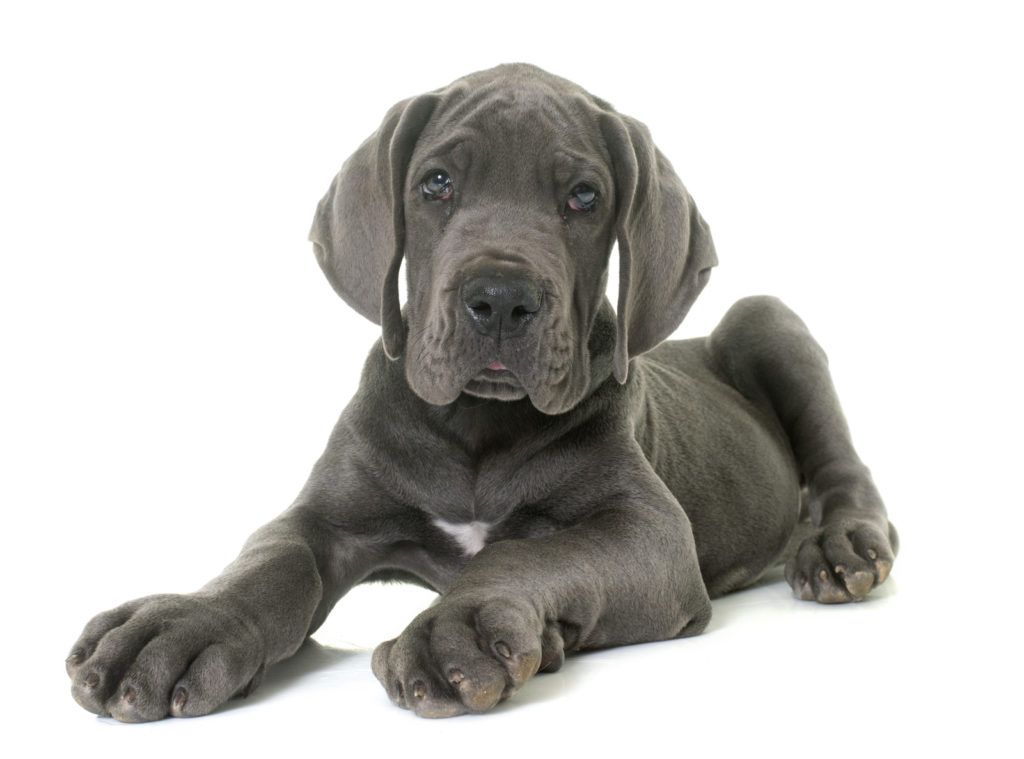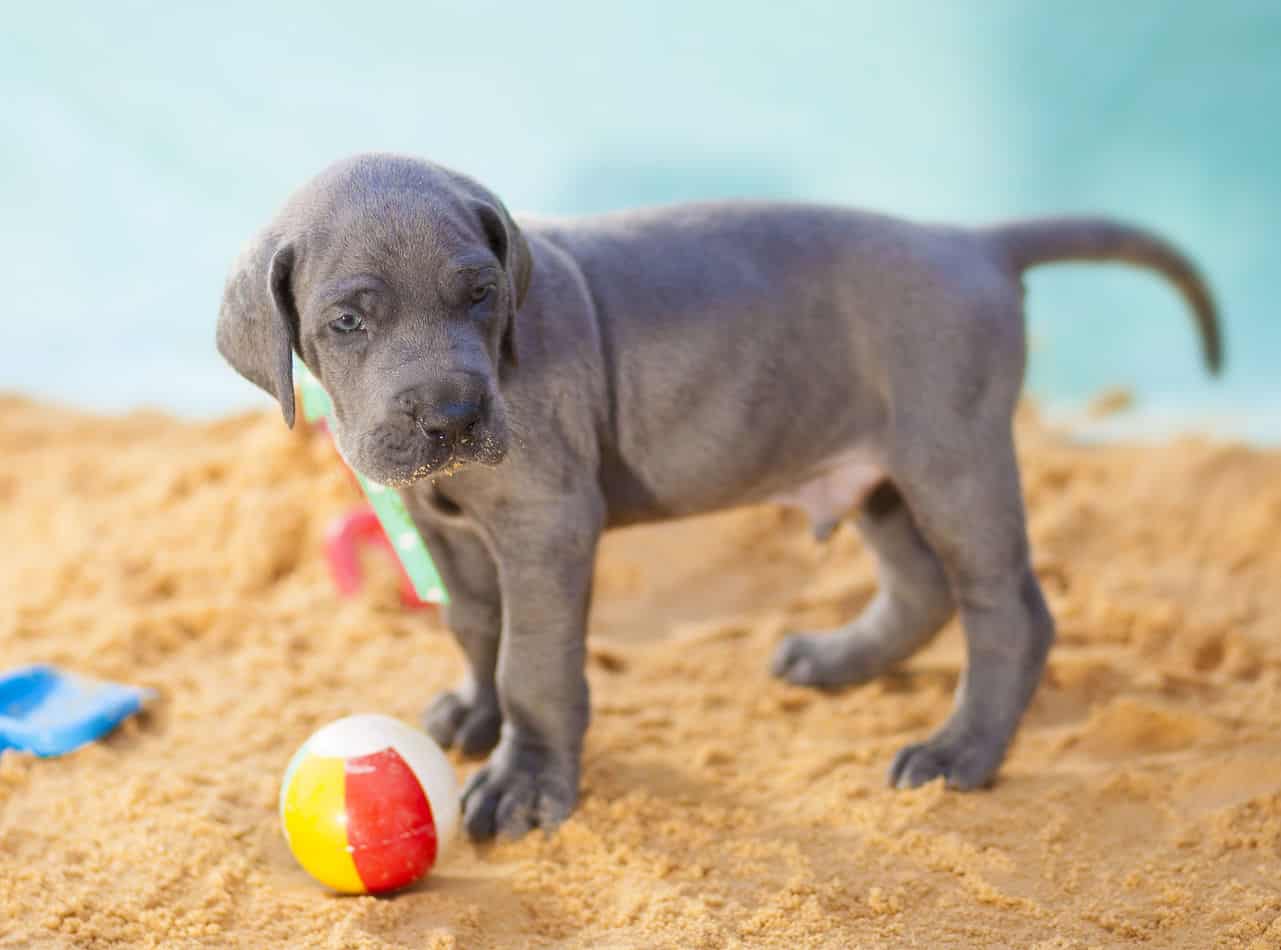Great Danes are a giant breed of dog that can suffer from a serious and potentially life-threatening condition called bloat. Unfortunately, this condition can occur at any age, including in Great Dane puppies. Bloat occurs when the stomach fills with gas or fluid and becomes twisted, cutting off blood flow to the organs.
Great Dane puppies are particularly susceptible to bloat due to their deep chest cavities. This means that they have more space for their stomach to move around, which can increase the risk of the stomach twisting. While there is no guaranteed way to prevent bloat from occurring, there are steps that Great Dane owners can take to reduce the risk of their puppies developing this condition.
It's important for Great Dane owners to be aware of the signs of bloat in puppies, as early intervention can be critical for a positive outcome. By understanding the risk factors and symptoms of bloat in Great Dane puppies, owners can take steps to keep their furry friends healthy and happy.

Understanding Bloat in Dogs
Bloat, also known as gastric dilatation-volvulus (GDV), is a life-threatening condition that affects dogs of all ages, breeds, and sizes. It occurs when the stomach fills with gas or fluid, causing it to expand and twist on itself. This can lead to a blockage of blood flow to the stomach and other organs, which can cause tissue damage, shock, and even death.
Canine bloat is a medical emergency that requires immediate veterinary attention. If you suspect that your Great Dane puppy is experiencing bloat, you should seek veterinary care as soon as possible.
There are several risk factors that can increase the likelihood of bloat in dogs. These include breed, age, sex, diet, stress, and exercise. Some breeds, such as Great Danes, are more susceptible to bloat than others due to their deep chests and narrow waists. Additionally, older dogs and male dogs are more likely to develop bloat than younger dogs and female dogs.
Preventing bloat in dogs involves a combination of management strategies, including feeding smaller, more frequent meals, avoiding exercise before and after meals, and reducing stress. Some veterinarians also recommend using elevated feeding bowls and adding probiotics to the diet to help promote healthy digestion.
In summary, bloat is a serious and potentially life-threatening condition that can affect dogs of all ages, breeds, and sizes. It is important for Great Dane puppy owners to be aware of the risk factors and take steps to prevent bloat from occurring. If you suspect that your puppy is experiencing bloat, seek veterinary care immediately.
Great Danes and the Risk of Bloat
Great Danes are a large breed of dogs that are known for their gentle nature and loving temperament. Unfortunately, they are also prone to a serious health condition known as bloat, which can be life-threatening if not treated promptly.

Bloat is a condition that occurs when a dog's stomach fills with gas, causing it to expand and twist on itself. This can cut off blood flow to the stomach and other organs, leading to tissue damage and even death. Great Danes are particularly susceptible to bloat due to their deep chest cavities.
There are several risk factors that can increase a Great Dane's chances of developing bloat. Genetics plays a role, as some dogs may be predisposed to the condition. Other factors include eating too quickly, eating a large meal, drinking large amounts of water after eating, and exercising vigorously after eating.
Owners of Great Danes should be aware of the signs of bloat, which include a distended abdomen, restlessness, pacing, excessive drooling, and unproductive vomiting. If you suspect that your dog is suffering from bloat, it is important to seek veterinary care immediately.
While bloat cannot be fully prevented, there are steps that owners can take to reduce their dog's risk. These include feeding multiple small meals throughout the day instead of one large meal, using a slow feeder bowl to encourage slower eating, discouraging vigorous exercise after eating, and avoiding feeding your dog from a raised bowl.
In conclusion, Great Danes are at a higher risk of developing bloat due to their size and deep chest cavities. Owners should be aware of the risk factors and signs of bloat, and take steps to reduce their dog's risk. Prompt veterinary care is essential if bloat is suspected.
Signs and Symptoms of Bloat in Great Danes
Bloat, also known as gastric dilatation-volvulus (GDV), is a life-threatening condition that can occur in Great Danes. It is important for owners to be aware of the signs and symptoms of bloat so that they can seek veterinary care immediately if they suspect their dog is experiencing this condition.
One of the most common signs of bloat is a distended abdomen. This can occur rapidly and may be accompanied by dry heaving or retching. The dog may also appear restless or unsettled, pacing or unable to get comfortable. Drooling and excessive salivation are also common symptoms of bloat.
In severe cases, the dog may go into shock, which can be life-threatening. Pale gums and a rapid heartbeat are signs of shock and should be taken seriously. Other symptoms of bloat may include a distended stomach, enlarged abdomen, and signs of pain or discomfort.
Great Danes are at a higher risk of developing bloat due to their deep chests. Other high-risk breeds include Bloodhounds, Irish Wolfhounds, Standard Poodles, German Shepherds, Boxers, and Akitas. Fearful or anxious dogs may also be at a higher risk of developing bloat.
If you suspect that your Great Dane is experiencing bloat, it is important to seek veterinary care immediately. Time is of the essence when it comes to treating this condition, and delaying treatment can increase the risk of complications and death.
In summary, signs and symptoms of bloat in Great Danes include a distended abdomen, dry heaving or retching, restlessness, signs of pain or discomfort, drooling, and excessive salivation. Great Dane owners should be aware of the risk factors for bloat and seek veterinary care immediately if they suspect their dog is experiencing this condition.
Diagnosing Bloat in Great Dane Puppies
Diagnosing bloat in Great Dane puppies can be challenging, but it is critical to identify the condition early to prevent serious complications. If you suspect that your Great Dane puppy is suffering from bloat, you should immediately contact a veterinarian.
The veterinarian will perform a physical examination to check for signs of bloat, such as a distended abdomen, rapid heart rate, and difficulty breathing. They may also use a stethoscope to listen for abnormal sounds in the stomach.
In addition to the physical examination, the veterinarian may also recommend an x-ray to confirm the diagnosis. X-rays can help to identify the presence of gas or fluid in the stomach, as well as any twisting or rotation of the stomach.
Once the diagnosis of bloat is confirmed, immediate treatment is necessary to prevent the condition from becoming life-threatening. Treatment options may include decompression of the stomach, surgery to untwist the stomach, and medication to stabilize the dog's condition.
In conclusion, if you suspect that your Great Dane puppy is suffering from bloat, it is critical to seek veterinary care immediately. A timely diagnosis and treatment can help to prevent serious complications and save your puppy's life.
Emergency Care and Treatment for Bloat
Bloat in Great Dane puppies is a medical emergency that requires immediate veterinary care. If you suspect that your Great Dane puppy is suffering from bloat, you should take them to the nearest animal hospital or emergency veterinary clinic right away.

In an emergency situation, the veterinarian will first stabilize your puppy's condition. This may involve administering oxygen, IV fluids, and pain medication. The vet will then perform a physical examination to confirm the diagnosis of bloat.
If the diagnosis is confirmed, the vet will perform emergency surgery to relieve the pressure in your puppy's abdomen. During the surgery, the vet will make an incision in your puppy's stomach and release the trapped gas and fluid. The vet may also perform a gastropexy, which is a surgical procedure that attaches the stomach to the abdominal wall to prevent future occurrences of bloat.
After the surgery, your puppy will need to stay in the hospital for several days for monitoring and recovery. The vet will provide you with instructions for caring for your puppy at home, including any necessary medications and follow-up appointments.
It is important to note that bloat is a surgical emergency, and delaying treatment can result in serious complications or even death. If you suspect that your Great Dane puppy is suffering from bloat, do not hesitate to seek emergency veterinary care.
Preventing Bloat in Great Dane Puppies
Bloat is a serious condition that can affect Great Dane puppies. It occurs when the stomach fills with gas and puts pressure on the diaphragm, making it difficult for the puppy to breathe. Bloat can be life-threatening, so it is important to take steps to prevent it. Here are some tips on how to prevent bloat in Great Dane puppies:
- Provide multiple small meals: Instead of feeding your Great Dane puppy one large meal, provide 2-3 smaller meals throughout the day. This can help prevent the stomach from becoming too full and reduce the risk of bloat.
- Use a slow feeder: Great Danes are known for being fast eaters, which can increase the risk of bloat. Consider using a slow feeder bowl to help your puppy eat more slowly and prevent them from gulping down their food too quickly.
- Wait after eating before exercise: It is important to wait at least one hour after your puppy has eaten before engaging in exercise. This can help prevent the stomach from twisting and reduce the risk of bloat.
- Make diet changes gradually: If you need to change your puppy's diet, do so gradually over the course of several days. Sudden changes in diet can increase the risk of bloat.
- Consider gastropexy surgery: Gastropexy surgery is a procedure that can help prevent bloat in Great Danes. It involves attaching the stomach to the abdominal wall to prevent it from twisting. Talk to your veterinarian to see if gastropexy surgery is right for your puppy.
By following these tips, you can help reduce the risk of bloat in your Great Dane puppy. Remember to always monitor your puppy for signs of bloat and seek veterinary care immediately if you suspect your puppy may be suffering from this condition.

Role of Genetics and Breeding in Bloat
Bloat is a life-threatening condition that can affect any dog breed, including Great Danes. Genetics has been proven to contribute to bloat, and it is crucial to understand the role of genetics and breeding in this condition.
There are risk alleles in genetic lines that show that if a grandparent, etc. has bloated, the future dogs in the lineage are more likely to bloat as well. Therefore, it is essential to check both the male and female's pedigree and ask a lot of questions to the breeder about whether there is a history of bloat in the lineage.
It is also important to note that bloat can occur in any dog breed, but it is more common in large breed dogs like Great Danes, German Shepherds, Standard Poodles, Irish Setters, Gordon Setters, St. Bernards, and Doberman Pinschers. Therefore, it is crucial to choose a reputable breeder who understands the risks and has taken necessary precautions to avoid breeding dogs with a history of bloat.
Breeding dogs with a history of bloat can increase the likelihood of passing on the risk alleles to their offspring, making them more susceptible to bloat. Therefore, it is crucial to choose a breeder who carefully selects breeding pairs based on their health records and pedigree.
In conclusion, genetics and breeding play a significant role in the development of bloat in Great Dane puppies and other dog breeds. It is essential to choose a reputable breeder who understands the risks and has taken necessary precautions to avoid breeding dogs with a history of bloat.
Post-Bloat Recovery and Care
After a Great Dane puppy has been treated for bloat, it is important to provide adequate post-bloat recovery and care to ensure a smooth and successful recovery. Recovery time can vary depending on the severity of the condition and the treatment received.
During the recovery period, it is important to monitor the puppy's gut health closely. Probiotics can be helpful in restoring the balance of good bacteria in the gut and promoting healthy digestion. The veterinarian may also recommend a specific diet or feeding schedule to aid in the recovery process.
It is important to follow all post-operative instructions provided by the veterinarian, including any medication schedules and restrictions on activity. The puppy may need to be kept on a leash or in a confined space to prevent excessive movement and further complications.
Regular check-ups with the veterinarian are important during the recovery period to monitor progress and address any concerns. It is also recommended to stay informed about Great Dane care through resources such as a Great Dane care newsletter.
If the puppy requires any additional medical procedures or surgeries during the recovery period, anesthesia may be necessary. It is important to discuss any concerns about anesthesia with the veterinarian and follow all pre-operative and post-operative instructions to ensure a safe and successful procedure.
Overall, providing proper post-bloat recovery and care is crucial in ensuring the health and well-being of a Great Dane puppy after experiencing bloat.




